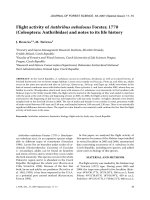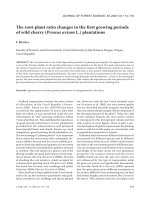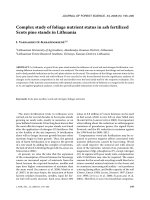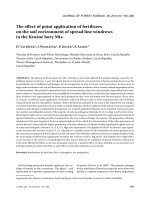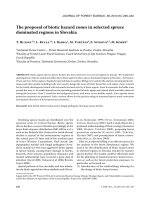Báo cáo lâm nghiệp: "Internal levels of plant growth regulators during in vitro culture of wild cherry (Prunus avium L.)" doc
Bạn đang xem bản rút gọn của tài liệu. Xem và tải ngay bản đầy đủ của tài liệu tại đây (191.67 KB, 4 trang )
Internal
levels
of
plant
growth
regulators
during
in
vitro
culture
of
wild
cherry
(Prunus
avium
L.)
P.
Label
1
D. Cornu
B. Sotta
2
E.
Miginiac
1
INRA,
Station
dAm6lioration
des
Arbres
Forestiers,
Ardon,
45160
Olivet,
and
2
Université
P et-M Curie,
Laboratoire
de
Physiologie
du
Dweloppement
des
Plantes,
4,
pl.
Jussieu,
T53-E5,
75252
Paris
Cedex
05,
France
Introduction
In
vitro
micropropagation
of
wild
cherry
is
presently
one
of
the
main
commercial
ways
to
clonally
propagate
this
species
(Cornu
and
Boulay,
1986).
In
order
to
extend
this
technique
to
a
large
number
of
clones,
it
seems
necessary
to
improve
our
knowledge
of
the
behavior
of
the
explants
during
the
in
vitro
culture.
Since
plant
growth
regulators
(PGR)
play
an
important
role
in
this
technique
(Margara,
1961
), our
attention
was
drawn
to
the
effect
of
exo-
genous
PGR
on
hormonal
levels
in
the
explants.
Materials
and
Methods
Wild
cherry
explants
were
cultured
according
to
the
procedure
described
by
Riffaud
and
Cornu
(1981
The
micropropagation
technique
can
be
schematically
divided
into
3
stages:
the
multipli-
cation
stage,
when
axillary
bud
growth
is
promoted
by
an
almost
equal
amount
of
indole-
3-butyric
acid
(IBA,
4.9 pM)
and
benzyladenine
(BA,
4.4
pM)
in
the
culture
medium;
the
elonga-
tion
phase
which
was
not
studied;
and
the
rooting
phase,
in
which
IBA
(4.9
pM)
alone
promoted
root
formation.
Hormonal
measurements
were
made
during
the
multiplication
and
the
rooting
stages.
For
each
measurement,
48
explants
were
divided
into
3
parts:
the
apical
part,
including
the
apex
sensu
stricto
and
the
youngest
leaves
inserted
in
the
short
internodes
of
the
stem
tip;
the
middle
part
of
the
explants,
bearing
the
oldest
leaves
at
the
axis,
whose
axillary
buds
started
to
grow
during
multiplication
treatment;
and
the
basal
part
including
the
portion
of
the
stem
inserted
into
the
culture
medium,
where
roots
were
formed
during
the
rooting
stage.
For
each
series,
explants
were
collected
0, 1,
2,
4
and
8
d
after
their
transfer
into
fresh
medium.
Frozen
samples
were
lyophilized
and
ground
up
with
a
ball
mill.
Analytical
measure-
ments
were
made
following
the
procedure
reported
elsewhere
(Label
et
al.,
1989).
Tech-
niques
used
were
methanolic
extraction,
HPLC
purification
and
fractionation,
and
immunolog-
ical
measurement
(ELISA),
(Leroux
et aL,
1985;
Maldiney
et al.,
1986;
Sotta
et al.,
1987;
Label
and
Sotta,
1988).
ELISA
measurements
were
repeated
5
times.
Mean
values
are
given.
Results
Morphological
development
Under
standard
multiplication
conditions
(Fig.
1 A,
B and
C),
axillary
buds
located
in
the
middle
part
of
the
explants
started
to
grow
on
d
4
and,
after
4
wk
of
culture,
the
multiplication
rate
was
3.
When
IBA
was
omitted
from
this
culture
medium
(Fig.
1
B
and
C),
no
multiplication
was
observable;
moreover,
82%
of
the
explants
were
necrotic
at
the
4th
wk.
When
BA
was
omitted
from
the
standard
multiplication
medium
(Fig.
1 A),
about
65%
of
the
explants
were
rooted
4
wk
after
sub-
culture.
Under
standard
rooting
conditions
(Fig.
1 D),
first
root
primordia
were
histologically
observable
on
d
5
and,
after
3
wk
of
culture,
80%
of
the
explants
had
at
least
one
root.
When
IBA
was
omitted
from
this
culture
medium
(Fig.
1 D),
3%
of
the
explants
were
rooted
at
the
3rd
wk.
Hormonal
measurements
Endogenous
hormonal
levels
are
pre-
sented
on
the
same
unit
scale
in
each
figure
(with
and
without
exogenous
PGR).
This
was
done
to
point
out
some
specta-
cular
differences
between
hormonal
levels
in
the
explants
according
to
treatment.
For
instance,
in
Fig.
1 C
and
D,
without
IBA
in
the
culture
medium,
IAA
levels
were
very
low
(grey
background),
but
the
apico-basal
distribution
of
this
hormone
in
the
explants
was,
nevertheless,
significant.
Results
are
presented
in
nmol
’
g-
1
DW;
to
approxi-
mately
convert
them
into
nmol!explant-!,
measurements
given
in
the
apical,
middle
and
basal
part
will
be
multiplied
by
3,
2
and
1,
respectively.
Discussion
and
Conclusion
A
relationship
between
IBA
and
endo-
genous
IAA
can
be
evoked.
In
each
experiment,
when
explants
were
cultured
with
IBA
(multiplication,
rooting)
in
the
culture
medium,
internal
IAA
was
baso-
apically
distributed
in
the
explants
and
IAA
levels
were
20-30
times
higher
than
in
explants
cultured
without
IBA,
where
IAA
is
apico-basally
distributed.
Epstein
and
Lavee
(1986)
reported
a
transformation
of
IBA
into
IAA
during
in
vitro
culture
of
Vitis
vinifera
and
Olea
europea.
The
chemical
pathway
could
be
a
0-oxidation
of
the bu-
tyric
side
chain,
but
the
biochemical
mech-
anism
of
this
process
remains
unknown.
From
the
experiments
run
in
the
presence
and
in
the
absence
of
BA
in
the
culture
medium
(Fig.
1 B),
we
postulate
that
IBA
might
control
the
penetration
of
BA
into
the
explants.
We
still
have
to
investigate
this
point,
and
experiments
using
radiolabeled
IBA
and
BA
would
be
of
great
interest
in
this
perspective.
The
last
result
was
not
illustrated
because
of
its
strong
clarity:
when
BA
was
present
in
the
culture
medium
(with
or
without
IBA),
no
natural
cytokinins
could
be
detected
in
the
explants,
whereas
each
time
BA
was
removed
from
the
culture
medium,
natural
cytokinins
could
be
quantified
by
the
ELISA
technique.
Thus,
BA
had
a
clear
depressive
effect
on
endogenous
natural
cytokinin
metabolism.
Although
BA
metabolism
is
well
known
(Letham
and
Palni,
1983),
results
on
the
effect
of
BA
on
endogenous
cytokinin
metabolism
have
never
been
published.
In
the
future,
the
intensity
of
this
depressive
effect
and
the
biological
activity
of
this
synthetic
PGR
should
be
explored.
Acknowledgments
The
technical
assistance
of
P.
Capelli
and
R.
Camelin
is
gratefully
acknowledged.
This
work
was
partly
supported
by
a
grant
(no.
4473)
from
INRA.
References
Cornu
D.
&
Boulay
M.
(1986)
La
multiplication
vegetative.
Techniques
horticoles
et
culture
in
vitro.
Rev.
For.
Fr.
38,
60-68
Epstein
E.
&
Lav6e
S.
(1986)
Conversion
of
indole-3-butyric
acid
to
indole-3-acetic
acid
by
cuttings
of
gravepine
(Vitis
vinifera)
and
olive
(Olea
europea).
Plant
Cell
Physiol.
253,
697-
703
Label
P.
&
Sotta
B.
(1988)
An
ELISA
test
for
BA
measurement:
application
to
wild
cherry
culture
in
vitro.
Plant
Cell
Tissue
Organ
Culture
1,
155-
158
Label
P.,
Maldiney
R.,
Sossountzov
L.,
Cornu
D.
&
Miginiac
E.
(1989)
Endogenous
levels
of
abscisic
acid,
indole-3-acetic
acid
and
benzyladenine
during
in
vitro
bud
growth
induc-
tion
of
wild
cherry
(Prunus
avium
L.).
Plant
Growth
Regul.
8,
325-333
Leroux
B.,
Maldiney
R.,
Miginiac
E.,
Sos-
sountzov
L.
&
Sotta
B.
(1985)
Comparative
quantitation
of
abscisic
acid
in
plant
extracts
by
gas-liquid
chromatography
and
an
enzyme-
linked
immunosorbent
assay
using
the
avi-
din-biotin
system.
Planta
166,
524-529
Letham
D.S.
&
Palni
L.M.S.
(1983)
The
bio-
synthesis
and
metabolism
of
cytokinins.
Annu.
Rev.
Plant Physiol.
34, 163-197
Maldiney
R.,
Leroux
B.,
Sabbagh
L,
Sotta
B.,
Sossountzov
L.
&
Miginiac
E.
(1986)
A
bio-
tin-avidin-based
enzyme
immunoassay
to
quantify
three
phytohormones:
auxin,
abscisic
acid
and
zeatin
riboside.
J.
Immunol.
Methods
90, 151-158
Margara
J.
(1961)
Les
corr6lations
d’inhibition.
Ann.
Physiol.
V6g.
8,
55-69
Riffaud
J.L.
&
Cornu
D.
(1981)
Utilisation
de
la
culture
in
vitro
pour
la
multiplication
de
meri-
siers
adultes
(Prunus
avium
L.)
s6lectionn6s
en
foret.
Agronomie
1,
633-640
Sotta
B.,
Pilate
G.,
Pelese
F.,
Sabbagh
I.,
Bon-
net
M.
&
Maldiney
R.
(1987)
An
avidin-biotin
solid
phase
ELIl3A
for
femtomole
isopentenyl-
adenine
and
isopentenyladenosine
measure-
ments
in
HPLC-purified
plant
extracts.
Plant
Physiol.
84,
571-573
